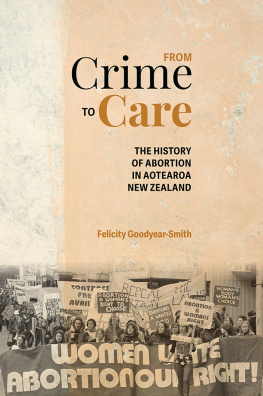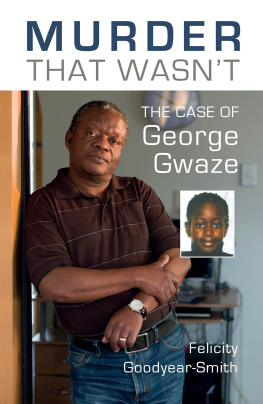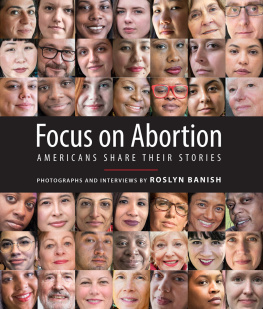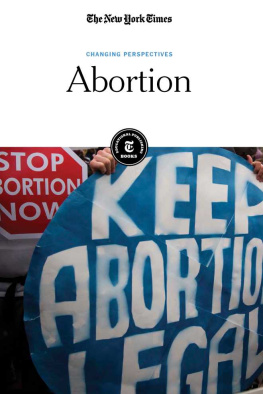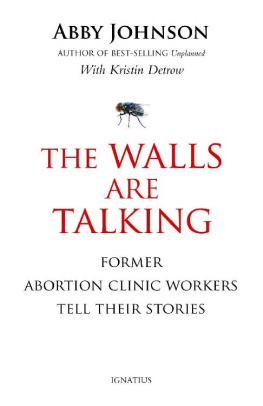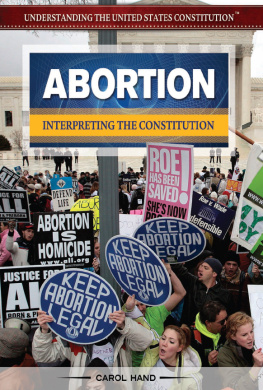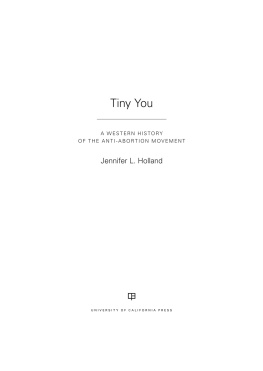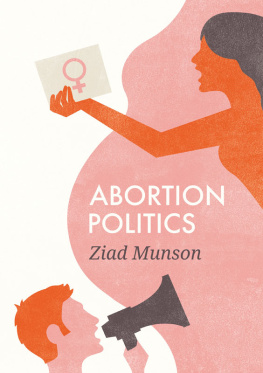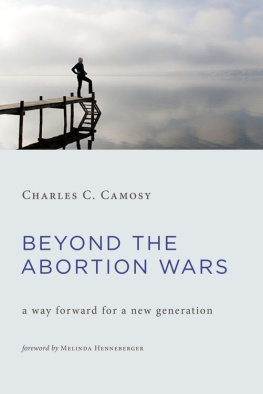

Verity Press
veritypress.com
Felicity Goodyear-Smith 2023
First published 2023
ISBN 978-0-473-66306-03
Also available as an ebook:
ePub 978-0-473-99307-0
Mobi Kindle 978-0-473-66309-07
A catalogue record for this book is available from the National Library of New Zealand.
This book is copyright. Apart from fair dealing for the purpose of private study, research, criticism or review, as permitted under the Copyright Act, no part may be reproduced by any process without the prior permission of the publisher.
Cover, interior design and layout: Julie McDermid/Punaromia Publications
Front cover image: Pro abortion demonstration, Wellington. Dominion Post (Newspaper): Photographic negatives and prints of the Evening Post and Dominion newspapers. Ref: EP/1976/2253/30A-F. Alexander Turnbull Library, Wellington, New Zealand.
Front cover background image: Illustration 260206 Elena Ray Microstock Library Elena Ray | Dreamstime.com
Printed in New Zealand
To Rexley (Rex) Blake Hunton,
my mentor, colleague and friend.
CONTENTS
LIST OF ILLUSTRATIONS
FOREWORD
Professor Felicity Goodyear-Smith is a distinguished academic, general practitioner, researcher, teacher and writer, one who is well positioned to write on abortion. From 1981 until 2020, when the role was abolished by reforming legislation, she was a Certifying Consultant, interviewing, assessing and approving abortions under now rejected legal grounds. For most of that time she was employed by the Auckland Medical Aid Centre, so it is not surprising that she tells the story of this ground-breaking clinic in greater detail than other services which came later. It is also not surprising that she dedicates this book to the clinics founder Dr Rex Hunton, who by his initiative in 1974 began the process that changed the way medical professionals treat abortion and inspires the theme of this book from crime to care. By interviewing others from places outside Auckland, the author has been able to expand on the history and practice of abortion throughout New Zealand. She is familiar with controversy and characteristically includes interviews with those opposed to abortion.
Her account spans three centuries, from early practices in the nineteenth century to modern times. Legal milestones include the harsh laws in 1867, with changes in 1893, 1908 and belatedly in 1977. Even when the Crimes Act was given an overhaul in 1961 the section on abortion escaped revision. During this time illegal abortionists flourished and were regrettably an accepted part of New Zealand culture. That changed somewhat in 1969 and 1971 when Australian court cases opened the way for New Zealand women, who could afford it, to travel to Melbourne or Sydney for a legal abortion. A more significant milestone was the opening of the Auckland clinic in 1974, which led to the Woolnough trials in 1975, the Report of the Royal Commission in March 1977, and the complicated legislation of December 1977. The new law led to the setting up of a new system of certifying consultants, overseen by an Abortion Supervisory Committee which problematically endured for over four decades until decriminalisation in March 2020.
Do we need another book on abortion? Yes, I believe that if we are to reduce the stigma associated with abortion, we need to keep telling these stories. Our future depends on a greater understanding of our history. This readable account may inspire others to add to the literature on abortion and we need to hear not only from the medical perspective but also from other angles. A welcome new direction is that abortion themes appear more often in works of fiction, film, theatre, poetry and art. It is an evolving saga.
Dame Margaret Sparrow DNZM MBE
2020 Senior New Zealander of the Year
ABBREVIATIONS
| ALRA | Abortion Law Reform Association (Britain) |
| ALRANZ | Abortion Law Reform Association of New Zealand |
| AMAC | Auckland Medical Aid Centre |
| AMAT | Auckland Medical Aid Trust |
| APGANZ | Abortion Providers Group Aotearoa New Zealand |
| ASC | Abortion Supervisory Committee |
| COHAB | Committee to Oppose the Hospitals Amendment Bill |
| CRASH | Center for Reproductive and Sexual Health [USA] |
| CS&A Act 1977 | Contraception, Sterilisation and Abortion Act 1977 |
| D&C | dilation and curettage |
| DHB | District Health Board |
| EDU | Epsom Day Unit |
| EMA | early medical abortion |
| HPCA Act | Health Practitioners Competence Assurance Act |
| IUD | intrauterine device |
| LARC | long-acting reversible contraception |
| MP | Member of Parliament |
| NARAL | National Abortion Rights Action League |
| NIPS | non-invasive prenatal genetic screening |
| NOW | National Organisation for Women |
| NZHPA | New Zealand Health Professionals Alliance |
| O&G | obstetrician and gynaecologist |
| QC | Queens Counsel |
| SOS | Sisters Overseas Service |
| SPUC | Society for the Protection of the Unborn Child |
| WONAAC | Womens National Abortion Action Campaign |
PREFACE
When I was a medical student in the 1970s, I was taught by Dr Rex Hunton and Father Felix Donnelly who worked in the Department of Community Health. They provided counselling services in the Pink Cottage, a little building on the grounds of our newly built medical school opposite Auckland Hospital. Rex and his wife Valerie ran experiential workshops using multimedia and psychodrama techniques, enabling participants to extend their creative abilities and improve their relationship skills. I attended a couple of these and found them both fun and inspiring. Rexs focus was always on the importance of human relationships. His patient-centred approach to medical practice helped shape my future medical career, and I have remained in contact with Rex and Valerie throughout my life. Felix set up the free counselling service Youthline, and I served as a volunteer counsellor there while I was a student. In 1974 Rex was instrumental in opening the Auckland Medical Aid Centre (AMAC), Aotearoa New Zealands first abortion clinic, the story about which features prominently in this book. I have written this book in tribute to Rex, for his bravery in doing what he knew was right, regardless of the cost to himself and his family.
Apart from attending the occasional rally, I was not involved in abortion politics or the setting up of the clinic while I was at medical school. However, in 1981 I was a general practitioner in Freemans Bay, very involved in womens health care, including delivering many babies each year. I had never had an abortion myself, nor had I experienced the traumatic effects of illegal abortions. As with other aspects of health care, I saw that my role was to help my patients understand their conditions and their options, so that they could make the best possible decisions for their health care. In 1981 I started work at AMAC as an assessing certifying consultant, doing one session either weekly or fortnightly. I continued doing this until the beginning of the New Zealand COVID-19 lockdown in 2020, which coincided with the new legislation rendering that role redundant. I have never worked as an operating doctor.

